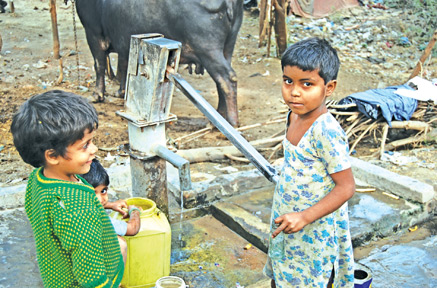Solutions for Asia's sanitation problems
Water is the elixir of life, the element that sustains all known
living organisms in their life cycle. Water is abundant in nature,
covering up the majority of the planet we call home.
 Yet, freshwater resources, which give us drinking water, irrigate
plants, and are often used to generate energy, are under threat on
several fronts across Asia and the Pacific. Water supply is approaching
a crisis point in many Asian countries, as communities, industries, and
farmers compete for this scarce resource. Yet, freshwater resources, which give us drinking water, irrigate
plants, and are often used to generate energy, are under threat on
several fronts across Asia and the Pacific. Water supply is approaching
a crisis point in many Asian countries, as communities, industries, and
farmers compete for this scarce resource.
Against this backdrop, it is crucial that governments and communities
learn how to make the most of their invaluable water assets. An area
where there is room for making strides and realising massive savings is
that of waste-water management.
In Asia and the Pacific, 1.7 billion people lack basic sanitation,
while 780 million still practise open defecation near rivers and other
places, posing severe health and environmental problems. Among them, 300
million people have mobile phones but do not have access to toilets.
"There are many reasons why sanitation is still a problem in Asia and
the Pacific," said senior urban specialist at ADB, Jingmin Huang.
"Some communities consider human waste a taboo for cultural reasons,
while the adoption of chemical fertiliser has changed the way some rural
communities dispose of waste. At times, governments tend to think that
sanitation is an expensive issue to tackle, although this is not
necessarily the case," he said.
Solutions, in fact, are at hand. No matter how poor a community may
be, technological and financial solutions are available for them to
benefit from modern sanitation practices.
In particular, small-scale projects such as localised septage
management and decentralised waste-water management are often the best
ways to address the sanitation needs of small communities around the
region.
Despite the scale and gravity of the problem, examples of good
sanitation practices in the region are aplenty.
ADB experts collected in a publication a series of new approaches and
working models on sanitation and waste-water management from different
countries.
"Not only do these projects illustrate how sanitation and waste-water
management challenges can be addressed, but they also inspire
replication and show opportunities for actions and investments," said
Jinmim.
The publication was conceived to provide an analysis of all possible
management strategies, so that practitioners can learn from others'
experiences, apply innovative approaches and tap potential markets.
ADB's involvement in sanitation is not limited to the crucial task of
generating and disseminating knowledge. It is also directly involved in
the development of sanitation projects across Asia and the Pacific.
In Bangladesh, with support from ADB, government and Non-Governmental
Organisations (NGOs) are tackling the challenge of creating a cleaner,
healthier environment in the crowded slums of Dhaka and other urban
centres.
 A growing trend in the country is toward on-site sewage treatment
systems and sludge management projects. A growing trend in the country is toward on-site sewage treatment
systems and sludge management projects.
"Not only do these projects improve sanitation coverage and
waste-water management," said Jingmin, "but they also show how
sanitation solutions can be sustainable thanks to the engagement of
local communities in general and women in particular."
In Yangon, Myanmar's largest city, urban services, such as
sanitation, are in a poor state. Many homes do not have proper toilets.
Faecal waste is discharged into gutters clogged with garbage, posing a
serious health hazard.
Thanks to a small-scale pilot community project supported by ADB, one
neighbourhood in a poor community has improved sanitation facilities and
hygiene practices, providing an example of how things can be done in the
country.
Will Asia and the Pacific to meet the ambitious Millennium
Development Goal 7 (MDG7), which aims at reducing by half the size of
the population who do not have access to sanitation by 2015?
Experts believe that this is possible, though a paradigm shift is
needed toward performance-based and business-oriented solutions that
include technological innovation, comprehensive financing and efficient
delivery mechanisms.
A lot has been done, and a lot remains to be done. And the goal of
universal access to sanitation by 2025, which might replace MDG7, is
already just around the corner.
- ADB |

